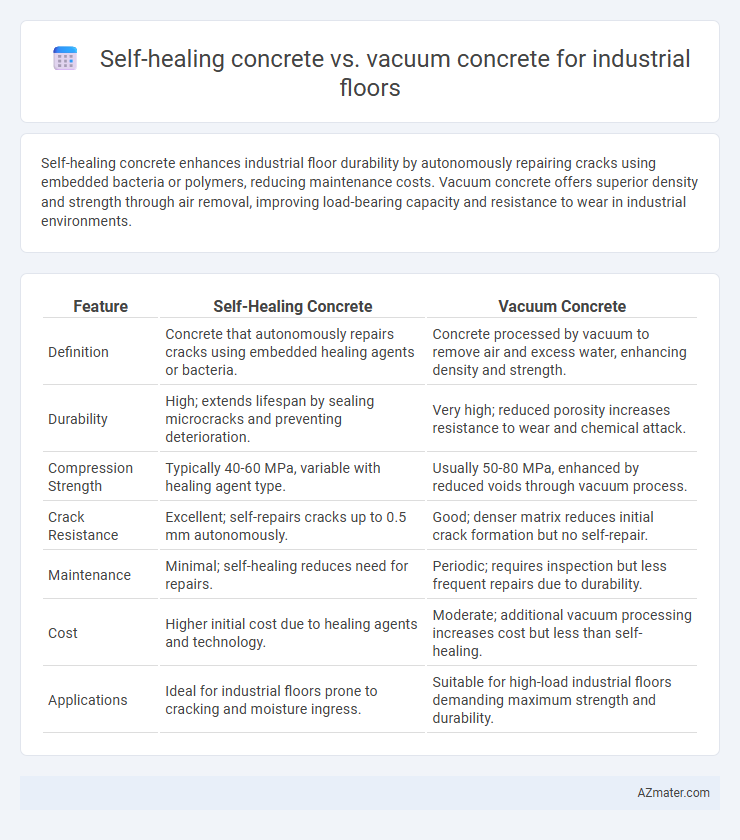Self-healing concrete enhances industrial floor durability by autonomously repairing cracks using embedded bacteria or polymers, reducing maintenance costs. Vacuum concrete offers superior density and strength through air removal, improving load-bearing capacity and resistance to wear in industrial environments.
Table of Comparison
| Feature | Self-Healing Concrete | Vacuum Concrete |
|---|---|---|
| Definition | Concrete that autonomously repairs cracks using embedded healing agents or bacteria. | Concrete processed by vacuum to remove air and excess water, enhancing density and strength. |
| Durability | High; extends lifespan by sealing microcracks and preventing deterioration. | Very high; reduced porosity increases resistance to wear and chemical attack. |
| Compression Strength | Typically 40-60 MPa, variable with healing agent type. | Usually 50-80 MPa, enhanced by reduced voids through vacuum process. |
| Crack Resistance | Excellent; self-repairs cracks up to 0.5 mm autonomously. | Good; denser matrix reduces initial crack formation but no self-repair. |
| Maintenance | Minimal; self-healing reduces need for repairs. | Periodic; requires inspection but less frequent repairs due to durability. |
| Cost | Higher initial cost due to healing agents and technology. | Moderate; additional vacuum processing increases cost but less than self-healing. |
| Applications | Ideal for industrial floors prone to cracking and moisture ingress. | Suitable for high-load industrial floors demanding maximum strength and durability. |
Introduction to Innovative Concrete Technologies
Self-healing concrete integrates microcapsules or bacteria that activate upon cracking to autonomously repair damage, significantly extending the lifespan and durability of industrial floors by reducing maintenance costs and downtime. Vacuum concrete employs advanced vacuum dewatering technology to enhance density and strength, ensuring superior load-bearing capacity and resistance to abrasion critical for heavy industrial applications. Both technologies represent breakthroughs in construction materials, optimizing performance and sustainability in industrial flooring solutions.
Understanding Self-Healing Concrete for Industrial Floors
Self-healing concrete incorporates microcapsules or bacteria that activate upon cracking, autonomously repairing fractures to maintain structural integrity and extend the lifespan of industrial floors. This innovative material reduces maintenance costs and downtime, proving especially beneficial in high-traffic industrial environments where durability and longevity are critical. Compared to vacuum concrete, which enhances strength through void reduction but lacks self-repair capabilities, self-healing concrete offers a proactive solution for sustaining optimal floor performance in demanding industrial settings.
What is Vacuum Concrete? Process and Applications
Vacuum concrete is a high-performance industrial flooring material produced by removing excess water through vacuum suction immediately after pouring, which enhances density and strength. This process reduces porosity, leading to improved durability, faster curing times, and enhanced resistance to abrasion and chemical attack, making it ideal for heavy industrial floors. Common applications include warehouses, factories, and distribution centers requiring robust floors capable of withstanding heavy machinery and high traffic.
Key Differences between Self-Healing and Vacuum Concrete
Self-healing concrete incorporates microcapsules or bacteria that trigger crack repair, enhancing durability and reducing maintenance costs in industrial floors. Vacuum concrete undergoes a vacuum dewatering process to remove excess water, resulting in higher density, faster setting times, and increased surface strength. Key differences include self-healing concrete's ability to autonomously repair damage over time, while vacuum concrete emphasizes immediate strength and reduced porosity through mechanical water extraction.
Durability and Lifespan in Industrial Environments
Self-healing concrete significantly enhances durability by autonomously repairing micro-cracks, reducing maintenance frequency and extending lifespan in harsh industrial environments. Vacuum concrete, characterized by its low porosity and high density, offers superior resistance to chemical attacks and mechanical wear, ensuring long-term structural integrity. While self-healing concrete actively addresses damage over time, vacuum concrete provides an inherently robust barrier, both critical for sustaining industrial floor performance under heavy loads and aggressive conditions.
Maintenance Requirements: Self-Healing vs Vacuum Concrete
Self-healing concrete significantly reduces maintenance requirements for industrial floors by autonomously repairing micro-cracks through embedded healing agents, minimizing downtime and repair costs. Vacuum concrete, while offering enhanced density and durability, still requires routine maintenance to address surface wear and potential cracking without self-repair capabilities. Industrial applications favor self-healing concrete for its long-term cost efficiency and reduced intervention in maintenance cycles compared to vacuum concrete.
Cost Implications and Long-Term Savings
Self-healing concrete reduces maintenance costs significantly by autonomously repairing micro-cracks, extending the lifespan of industrial floors and minimizing downtime expenses. Vacuum concrete, while initially more expensive due to advanced manufacturing processes, offers superior density and strength, resulting in enhanced durability and lower repair frequency over time. Evaluating long-term savings, self-healing concrete can offer more cost-effective maintenance solutions, whereas vacuum concrete presents benefits through robust structural integrity and reduced lifecycle repairs.
Environmental Impact and Sustainability
Self-healing concrete significantly reduces maintenance needs and extends the lifespan of industrial floors by autonomously repairing micro-cracks, minimizing resource consumption and waste generation. Vacuum concrete enhances durability by eliminating air voids, leading to higher density and reduced permeability, thus decreasing susceptibility to chemical damage and environmental degradation. Both technologies offer sustainable solutions, but self-healing concrete provides a more proactive approach to carbon footprint reduction through lowered repair frequency and material consumption.
Performance in High-Traffic Industrial Settings
Self-healing concrete enhances durability in high-traffic industrial floors by autonomously repairing micro-cracks, reducing maintenance costs and extending service life. Vacuum concrete offers superior density and compressive strength, providing robust resistance to heavy loads and abrasion in demanding industrial environments. Comparing both, self-healing concrete excels in longevity and crack mitigation, while vacuum concrete delivers immediate structural integrity and load-bearing performance.
Choosing the Right Concrete Solution for Industrial Floors
Self-healing concrete enhances durability by autonomously repairing microcracks, reducing maintenance costs and prolonging industrial floor lifespan, ideal for high-stress environments. Vacuum concrete offers superior compaction and strength through air removal, ensuring maximum load-bearing capacity and resistance to heavy machinery impact on industrial floors. Selecting between self-healing and vacuum concrete depends on balancing long-term durability needs with immediate strength requirements for optimal industrial floor performance.

Infographic: Self-healing concrete vs Vacuum concrete for Industrial floor
 azmater.com
azmater.com